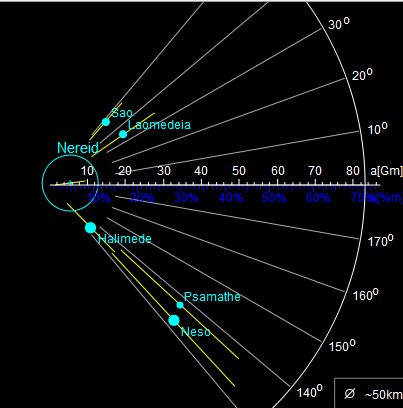Halimede (pronounced /ˈhælɨˈmiːdi/ HAL-i-MEE-dee, or as in Greek Αλιμήδη) is a retrograde irregular satellite of Neptune. It was discovered by Matthew J. Holman et al. on August 14, 2002.[5]

Irregular satellites of Neptune (*).
Halimede has the second most eccentric and third most inclined orbit around Neptune.[6] This is illustrated on the diagram in relation to other irregular satellites of Neptune. The satellites above the horizontal axis are prograde, the satellites beneath it are retrograde. The yellow segments extend from the pericentre to the apocentre, showing the eccentricity.
Halimede is about 62 kilometres in diameter (assuming an albedo of 0.04).[3] and appears neutral (grey) in the visible light. Given the very similar colour of the satellite to that of Nereid together with a high probability (41%[5]) of their collision in the lifespan of the Solar system, it has been suggested that the satellite could be a fragment of Nereid.[4]
Halimede, or Neptune IX, like many of the outer satellites of Neptune, is named after one of the Nereids, the fifty daughters of Nereus and Doris. Before the announcement of its name on February 3, 2007 (IAUC 8802), Halimede was known by the provisional designation S/2002 N 1.
References
1. ^ Discovery Circumstances from JPL
2. ^ Jacobson, R.A. (2008) NEP078 - JPL satellite ephemeris
3. ^ a b c S. Sheppard, D. Jewitt, J. Kleyna (2006). "A Survey for "Normal" Irregular Satellites Around Neptune: Limits to Completeness". Astronomical Journal 132: 171–176. arXiv:astro-ph/0604552.
4. ^ a b T. Grav, M. Holman, W. Fraser (2004). "Photometry of Irregular Satellites of Uranus and Neptune". Astrophysical Journal Letters 613: L77–L80. arXiv:astro-ph/0405605.
5. ^ a b M. Holman et al. (2004). "Discovery of five irregular moons of Neptune". Nature 430: 865–867. http://cfa-www.harvard.edu/~mholman/nature_final.pdf.
6. ^ D.R. Williams (23 November 2006). "Neptunian Satellite Fact Sheet". NASA. http://nssdc.gsfc.nasa.gov/planetary/factsheet/neptuniansatfact.html. Retrieved 2008-01-16.
* Ephemeris from IAU
* Mean orbital parameters from JPL
External links
* Matthew Holman's Neptune's page
* David Jewitt's pages
* Neptune's Known Satellites (by Scott S. Sheppard)
see also: The Solar System
Retrieved from "http://en.wikipedia.org/"
All text is available under the terms of the GNU Free Documentation License

